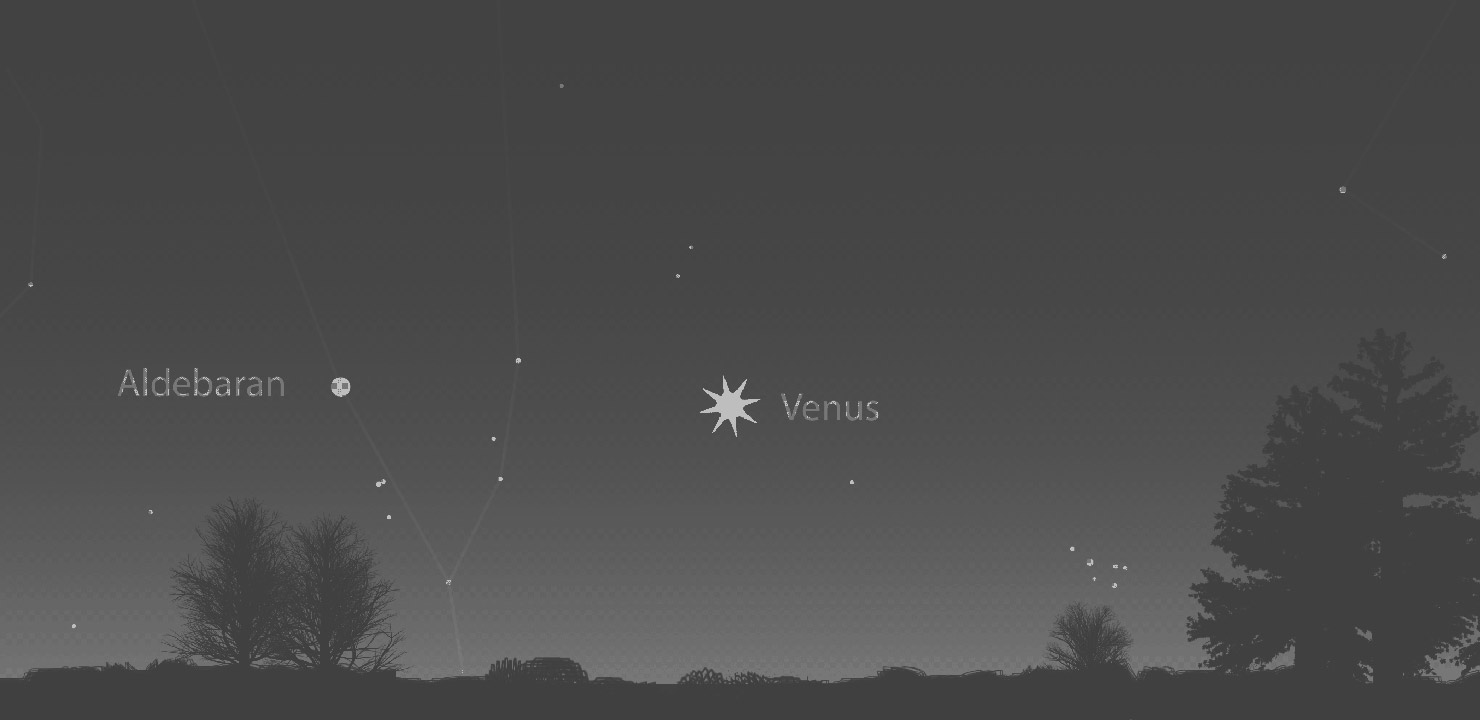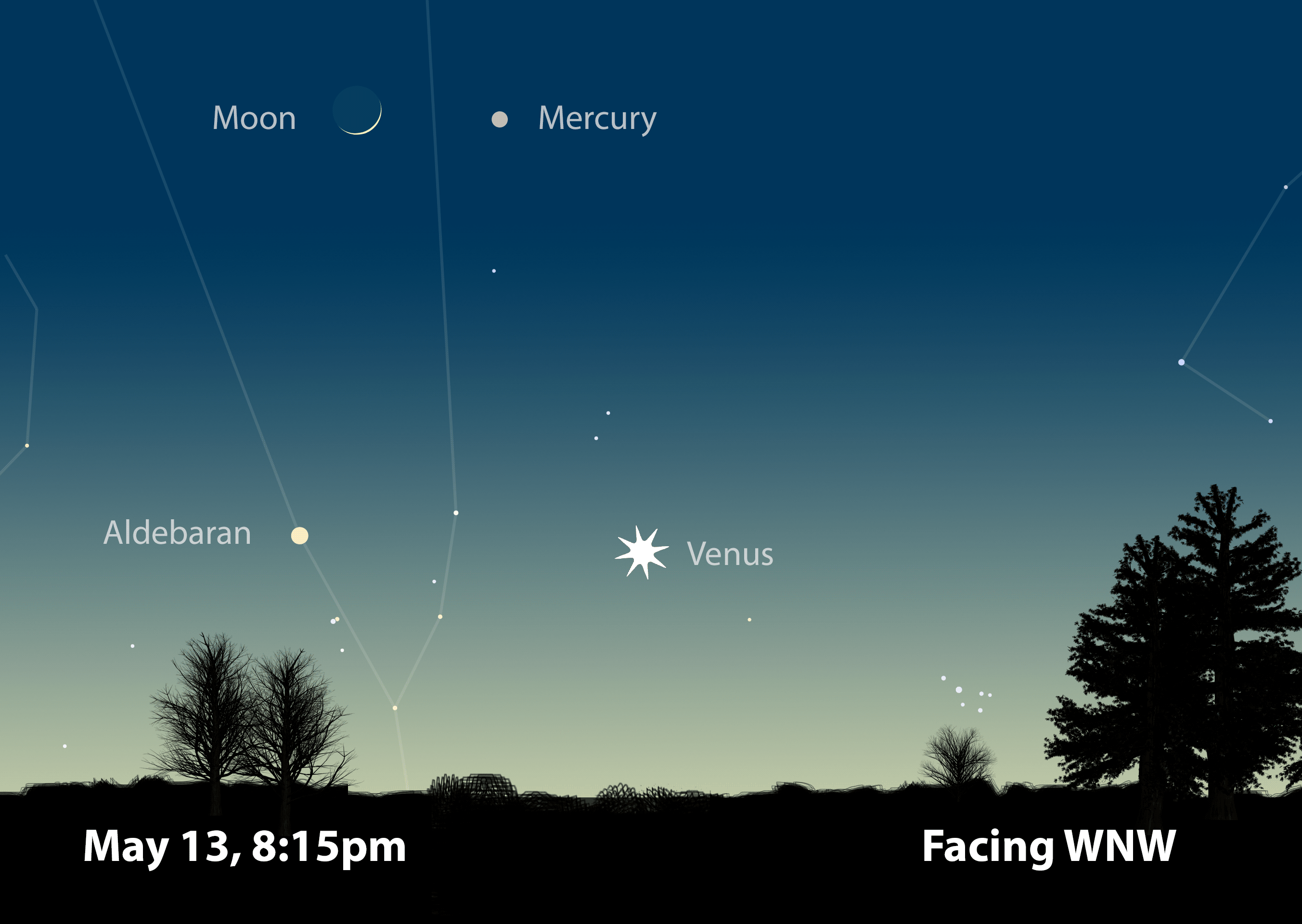
A Meteor Shower & A Look at Venus and Mercury
May 2021 :
Note: This article may contain outdated information
This article was published in the May 2021 issue of The Skyscraper and likely contains some information that was pertinent only for that month. It is being provided here for historical reference only.
For decades I have been informing local stargazers about astronomical events through my monthly columns. How many times have you read that I never tire of watching “burning rocks” blazing across the sky, no matter what time of the year? At least a couple of hundred I would estimate.
While the “burning rocks” description may seem appropriate, the outer surface of a meteor is actually being vaporized as it slams into the Earth’s atmosphere at many miles per second. That’s the glow or streak we observe as a shooting star. Some meteors may explode into fragments and continue to vaporize until they are completely annihilated. Once in a while a piece may survive its plunge and fall to the ground as a meteorite.
During the first week of May, we will be treated to the annual meteor display called the Eta Aquarids. This year the peak of activity occurs on the night of the 5th to the early morning of the 6th with perhaps 15 swift and yellow meteors radiating from the constellation of Aquarius (hence the name of the shower). The Earth will be sweeping through a stream of particles shed by Halley’s Comet long ago. The meteors comprising this meteor shower enter the Earth’s upper atmosphere head-on at 41-miles per second.
To locate Aquarius, look about 12 degrees above the east-southeast horizon around 4:00 a.m. The shower’s radiant point is in the Water Urn asterism (looks like a Y-shaped group of stars). While the meteors emanate from this region of the sky, scan around the entire sky to maximize your chances of observing one.
This recommendation is especially advisable, since a slender waning crescent Moon will also be residing in Aquarius just 14 degrees away from the radiant point. Regardless, this circumstance should not greatly interfere with observing as many meteors as possible in a dark sky away from light pollution. In fact, with the radiant so low in the sky you might even see some earth-grazers, meteors that skip along the top of our atmosphere like stones being skipped across a pond.
Also, during the first week of May keep your eyes on the west-northwest sky after sunset. We have several sky scenes that will grace this region of the heavens over a 20 day or so period. First, the planet Mercury will ascend into the evening sky. You’ll need an unobstructed view towards this direction. Each evening Mercury will be seen higher and higher above the horizon.

If you don’t identify it right away, wait for the evening of May 13 during deepening twilight around 8:15 p.m. when a slender waxing (growing larger) crescent Moon will be just about two degrees to the south (left) of Mercury. On this evening, or perhaps on the evening or two before, note a brilliant object below and slightly to the right of Mercury. This beacon will be Venus. As each night passes, Venus will rise higher into the night sky. On the night of the 17th Mercury will be at its highest elevation above the horizon. It will then begin to sink lower towards the horizon each night.
At the same time, Venus will continue to rise until it is in conjunction (close together) with Mercury on the 28th. The two worlds will be only one-half of a degree (angular size of a Full Moon) apart in the sky. Plan your observing location in advance, as this sky scene will only be about ten degrees above the west-northwest horizon. Mercury and Venus will be easy to view with the unaided eye, but binoculars or even a small telescope will enhance the view. Good luck.
On May 26 there is a total lunar eclipse, but unfortunately it will not be visible from Rhode Island. The May Full Moon, which Native Americans called the Full Flower Moon, is also the second supermoon of three for 2021. Since it will be closer to the Earth it may appear a little larger and brighter than a regular Full Moon. Technically the penumbral phase, when the Moon slides into the Earth’s lighter shadow, begins just before moonset from our location, in bright morning twilight. If you wish to observe more of this lunar eclipse you will have to travel much farther westward to do so.
You’d have to venture out to Wichita, Kansas to get a look at some part of totality. Or farther west to Pueblo, Colorado to observe all of totality. Coastal California will observe from the first penumbral shading through the end of the outgoing partial phase after totality. To experience this lunar eclipse in its entirety you’d need to be out in Hawaii.
Fear not. Lunar eclipses are far more numerous than solar eclipses. The next total lunar eclipse for us to see from start to finish will be on May 15-16, 2022.
And finally, if you are a regular reader of this column you may remember I asked you back in January if you knew where you had stored the solar eclipse glasses you had procured for the August 21, 2017 partial solar eclipse. Hopefully that inquiry encouraged you to begin your search in every nook and cranny in your home. If you didn’t, you now have just over a month to find them. Hint, they’ll be in the “last place you look” (late comedian George Carlin observation).
I want everyone to be prepared for the June 10 sunrise partial solar eclipse beginning at 5:15 a.m. As the Sun rises above the horizon on that morning the eclipse will already be in progress. While we often observe sunrises and sunsets through the dense atmosphere on the horizon, don’t be tempted to stare at the partially eclipsed Sun without those special solar eclipse glasses.
Next month’s column will be exclusively about this absolutely beautiful phenomenon.
Keep your eyes to the skies.



